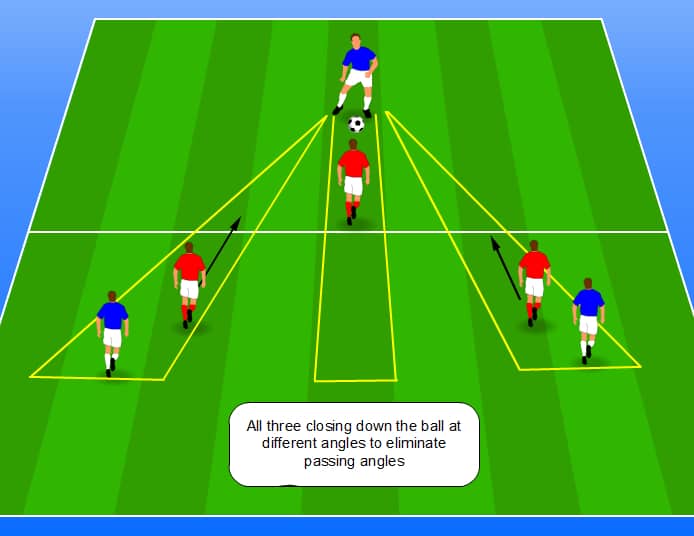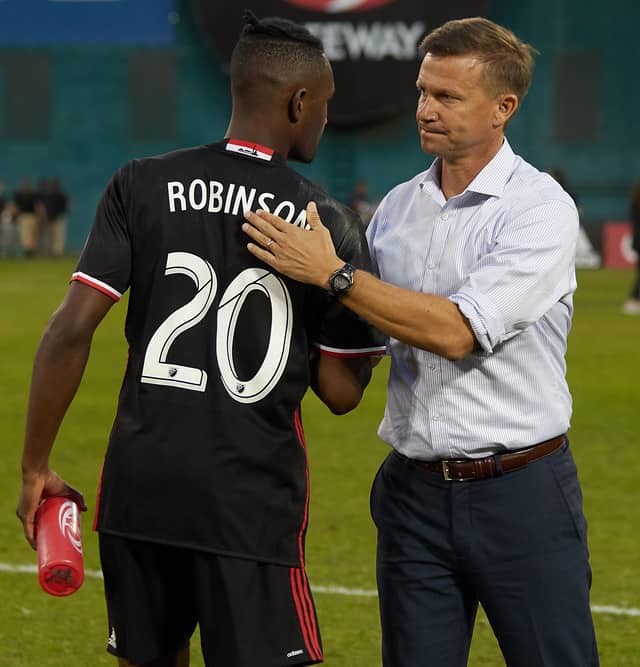I’m sure that you have heard the term gegenpressing before, especially those who follow Jurgen Klopp, who has had a lot of success with this style of football. So after thinking about adopting this style of play for my men’s team, Idecided to analyse this way of playing in much more detail.

The term gegenpressing basically means counter-pressing in German. The idea is for the team to recover the ball as quickly as possible and preferably in high areas of the field. This is achieved with a team working in cohesion by adopting the following principles:
- 1-2 players quickly close down the opposition player who has possession of the ball
- Support players close down the spaces to cut off passing lanes
- The rest of the team attach themselves tightly to players who could potentially receive the ball, ready to intercept.
This heavily relies on the front three being able and willing to work hard off the ball, resulting in a high possibility of winning the ball with a tackle, interception or with the opposition making a mistake (kicking the ball out of play, for example).
The gegenpressing formula allows a team to take quick advantage of the disorganisation of the opposition (through transition) who may have left potentially vulnerable spaces that can be exploited.
When the ball is won high up the pitch, close to the opposition’s goal, this means that it might only take one pass to penetrate the opposition and create a goal scoring opportunity.
As well as understanding how this form of counter-pressing works, during my research I found lots more information regarding the following questions:
- Where did gegenpressing come from?
- What other coaches use gegenpressing or a variation of the tactic?
In the rest of this blog I will share the information related to the above questions so that you have a full understanding of this tactic.
Where did gegenpressing come from?
Whilst I am not able to prove where this type of pressing tactic originated from, a good place to start might be with a different sport, such as ice hockey.
In 1934 Thomas Patrick Gorman was the coach of National Hockey League team, Chicago Blackhawks. Gorman decided to do exactly the opposite of all the other teams in the league, which was to drop off when they lost the ball, and instead instructed his players to close down the opposition close to their goal.
Even though it was a strange tactic for his players and it took a bit of time for the team to perfect, they would go on to win the league. The name of this tactic was forechecking.
Moving forward from 1934 to the 1970’s and back to football, this forechecking philosophy was used by one of the most respected & influential coaches of all time. Rinus Michels.
Michels used this aggressive pressing tactic to the extreme with the Netherlands national team at the 1974 world Cup. Upon losing possession, a swarm of orange shirts would run to the player with the ball like moths to a lightbulb.
This did cause a weakness with large spaces in behind the last defender. However, given that the player with the ball generally had no space to execute a long pass due to how effective the dutch team were at counter-pressing, this helped the Netherlands reach the World Cup final in addition to receiving great admiration for their style of play.
It must be noted that during that era any player in an offside position, regardless of interfering with play or not, was deemed offside.
As a visual aid to help you understand how the dutch team applied this tactic, at the end of this blog post, I have linked a video from the 1974 World Cup.
What other coaches use gegenpressing or a variation of the tactic?
There are variations in how the tactic can be applied to a team. Let’s first take a look at a number of coaches that have adopted this style and then examine some of the variations.
Coaches who utilise counter pressing::
- Liverpool – Jurgen Klopp
- Manchester City – Pep guardiola
- RB Salzburg – Jesse Marsch
- Leeds United – Marcelo Bielsa
- Tottenham Hotspur – Mauricio Pochotino
- Barcelona – Pep Guardiola
- Borussia Dortmund – Jurgen Klopp
Jugen Klopp
Since Jurgen Klopp seems to have made gegenpressing a hot topic in recent times, let’s start with how his Liverpool team carries out this tactic.
Klopp coaches his players to surround the opponent who has possession of the ball, usually having 2 to 4 players rushing towards the ball. This means, as with all the variations, that the team must execute this tactic in unison and know when to drop off to a more organised defensive shape.
It is important to remember that in order for this to work, players must react quickly in transition from attacking to defending and have good anticipation of where the opponent might pass the ball. If one player fails in his responsibilities then the whole structure of the team’s defending strategy may collapse.

Pep Guardiola
It is no surprise that Pep Guardiola, whilst utilising a variation of the tactic, uses a similar philosophy since it’s origins can be traced back to Rinus Michels. Michels had a big influence on Johan Cruyff who in turn had a similar effect on Guardiola.
Unlike Klopp’s Liverpool team, Pep’s Barcelona side did not have physically powerful players in the midfield areas but what they lacked in physical presence was compensated with footballing intelligence. Guardiola adapted the counter-pressing style to suit the likes of Xavi & Iniesta.
Instead of Barcelona attacking the ball carrier in numbers, the team would send the nearest player towards the ball with the closest supporting players blocking any available passing lanes whilst the remaining players positioned themselves tight to an opposition player, ready to intercept any pass that might beat the initial press.
(Visual Picture of How It Works)
Jesse Marsch

Recently Jesse Marsch, head coach of RB Leipzig, has quite often used the phrase forechecking when speaking about how his team plays.
Jesse has spoken about how German coach Ralf Ragnick made a big impact on his style of play, together with how he communicates these tactical ideas to his players.
Jesse explains that Germans use a single word to instruct the team to perform a specific tactical move and his translation for gegenpressing to American English was forechecking.
Just as Klopp and Guardiola have their own specific way of playing the counter-press, Jesse Marsch also has his own twist.
Marsch explains that when he watches other teams pressing the ball, they would tend to usually stop about a metre away from the opponent. For his team, they would go all in, without giving a yard of space.
Marsch states that his team does not counter-press to win the ball back, but they press to score.
Conclusion
Gegenpressing, or simply counter-pressing in English, has evolved overtime. Since it’s possible origins from ice hockey, under the name of forechecking, to the dutch national team that was lead by Rinus Michels where at times it appeared that nearly the whole team seemed to rush towards the ball like a school playground game.
Despite the variations that can be applied to counter-pressing football, in essence, the core objective remains the same. Win possession of the ball as quickly as possible.
If you would like to see the dutch team executing the counter pressing tactic then please click here.
